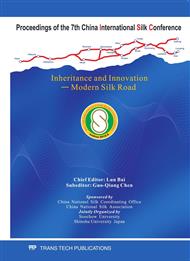p.539
p.545
p.549
p.554
p.559
p.565
p.570
p.575
p.580
Optimization of SPME with GCMS Analysis of Volatile Organic Chemical Residues in Textiles
Abstract:
A fast testing procedure for the determination of VOCs in textile matrix using solid phase microextraction (SPME) and gas chromatography-mass spectrometry (GC-MS) was introduced. Samples were cut into small pieces and soaked in 5% methanol (v/v) saturated NaCl solution with supersonic pretreatment at 40±1°Cwater-bathing for 15 min and headspace exposure for 10 min at 50°C with stirring rate at 1100rmp. The influence of SPME adsorption time, stir speed, adsorption time and temperature, and gas chromatography (GC) inlet conditions for the SPME were investigated. Then the matrix solutions were extracted by headspace SPME and analysis by GC/MS. Under the optimized conditions, the limits of detection for target compounds were 0.005mg/kg with average recovery between 90.6-108.7%. The results obtained clearly showed the potential of SPME for efficient concentration of the target compounds and also demonstrated the reliability of this extraction technique for the monitoring of textile quality for the eco-marks.
Info:
Periodical:
Pages:
559-564
Citation:
Online since:
January 2011
Authors:
Price:
Сopyright:
© 2011 Trans Tech Publications Ltd. All Rights Reserved
Share:
Citation:


